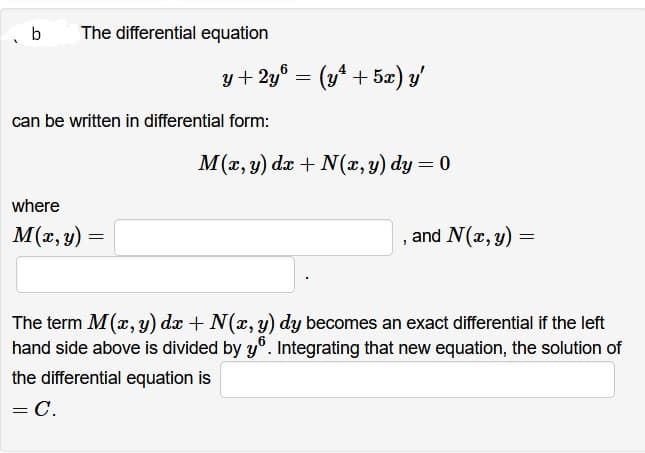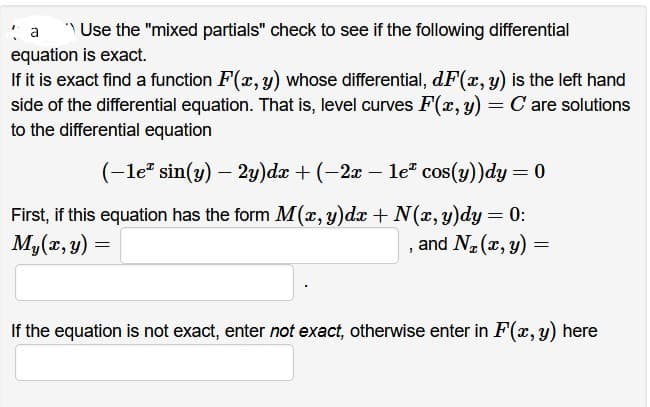b The differential equation y + 2y³ = (y² + 5x) y' can be written in differential form: where M(x, y) = M(x, y) dx + N(x, y) dy = 0 and N(x, y) = The term M(x,y) dx + N(x, y) dy becomes an exact differential if the left hand side above is divided by yº. Integrating that new equation, the solution the differential equation is
b The differential equation y + 2y³ = (y² + 5x) y' can be written in differential form: where M(x, y) = M(x, y) dx + N(x, y) dy = 0 and N(x, y) = The term M(x,y) dx + N(x, y) dy becomes an exact differential if the left hand side above is divided by yº. Integrating that new equation, the solution the differential equation is
Advanced Engineering Mathematics
10th Edition
ISBN:9780470458365
Author:Erwin Kreyszig
Publisher:Erwin Kreyszig
Chapter2: Second-order Linear Odes
Section: Chapter Questions
Problem 1RQ
Related questions
Question
100%
correct answer will get feedback

Transcribed Image Text:b
The differential equation
y + 2y³ = (y² + 5x) y'
can be written in differential form:
where
M(x, y) =
M(x, y) dx + N(x, y) dy = 0
and N(x, y) =
The term M(x,y) dx + N(x, y) dy becomes an exact differential if the left
hand side above is divided by yº. Integrating that new equation, the solution of
the differential equation is
= C.

Transcribed Image Text:a
Use the "mixed partials" check to see if the following differential
equation is exact.
If it is exact find a function F(x, y) whose differential, dF(x, y) is the left hand
side of the differential equation. That is, level curves F(x, y) = C are solutions
to the differential equation
(-1e* sin(y) - 2y)dx + (−2x − leª cos(y))dy = 0
First, if this equation has the form M(x, y)dx + N(x, y)dy = 0:
My(x, y)
and N₂(x, y)
=
=
If the equation is not exact, enter not exact, otherwise enter in F(x, y) here
Expert Solution
This question has been solved!
Explore an expertly crafted, step-by-step solution for a thorough understanding of key concepts.
Step by step
Solved in 2 steps with 2 images

Recommended textbooks for you

Advanced Engineering Mathematics
Advanced Math
ISBN:
9780470458365
Author:
Erwin Kreyszig
Publisher:
Wiley, John & Sons, Incorporated

Numerical Methods for Engineers
Advanced Math
ISBN:
9780073397924
Author:
Steven C. Chapra Dr., Raymond P. Canale
Publisher:
McGraw-Hill Education

Introductory Mathematics for Engineering Applicat…
Advanced Math
ISBN:
9781118141809
Author:
Nathan Klingbeil
Publisher:
WILEY

Advanced Engineering Mathematics
Advanced Math
ISBN:
9780470458365
Author:
Erwin Kreyszig
Publisher:
Wiley, John & Sons, Incorporated

Numerical Methods for Engineers
Advanced Math
ISBN:
9780073397924
Author:
Steven C. Chapra Dr., Raymond P. Canale
Publisher:
McGraw-Hill Education

Introductory Mathematics for Engineering Applicat…
Advanced Math
ISBN:
9781118141809
Author:
Nathan Klingbeil
Publisher:
WILEY

Mathematics For Machine Technology
Advanced Math
ISBN:
9781337798310
Author:
Peterson, John.
Publisher:
Cengage Learning,

